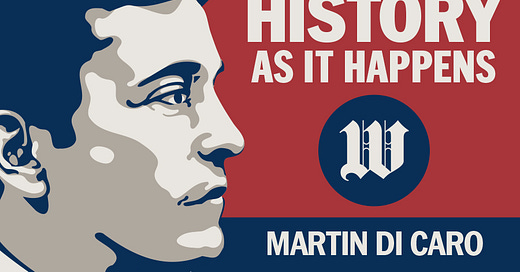Here is my review of “Did It Happen Here? Perspectives on Fascism and America” edited by Daniel Steinmetz-Jenkins. It was published in The Washington Times on April 25.
We’re told it’s only possible to resolve a problem by accurately identifying its source. When it comes to what’s ailing not merely the American system but global democracy more broadly, myriad diagnoses are offered. One especially continues to consume the minds of public intellectuals. It is fascism. This supposed relic of interwar Europe, synonymous with Hitler and Mussolini, is on the march in twenty-first century America, we are warned ad nauseam.
The question of whether fascism threatens American democracy became a liberal preoccupation from the moment Donald J. Trump rode his golden escalator in Trump Tower on June 16, 2015, to announce his run for the White House. Rather than seeing Mr. Trump as the product of American politics or, more precisely, the rise of anti-establishment populism over the past two to three decades, the purveyors of the fascism charge conjure images of the most despotic, destructive far-right regimes of the twentieth century. Or they argue we are witnessing an American fascism different than its European predecessors but still bent on trampling civil liberties, exalting the leader, and trashing the free press.
The fascism debate is percolating at a time of widespread ignorance of basic political and philosophical concepts, which may partly explain its staying power. We toss around allegations of socialism or fascism like salt and pepper on stew, smearing our opponents but rendering the terms meaningless. So maybe serious scholars can guide us to the right term for characterizing today’s real or wannabe autocrats.
In “Did It Happen Here? Perspectives on Fascism and America,” the Wesleyan University historian Daniel Steinmetz-Jenkins compiled 26 short essays, including his introduction, authored mainly by liberal or left-wing scholars during or shortly after Mr. Trump’s presidency. Six additional essays in this anthology are classic texts by such towering figures as Hannah Arendt and Reinhold Niebuhr.
Anthologies about a single subject can be repetitive, but “Did It Happen Here?” never bores because its contributors offer different ways of thinking about (alleged) fascism temporally and within different political contexts today, such as in Vladimir Putin’s Russia or Narendra Modi’s India. The essays arguing that Trump is a fascist often stretch the definition of fascism to the breaking point or fail to offer a cogent definition at all.
In the 1990s the British historian Roger Griffin, whose pen is curiously absent from this volume, posited a seminal theory in his “The Nature of Fascism” recognizing the centrality of national rebirth, or palingenesis, to fascist ideology. Fascists seek a political and social revolution not to return to the days of yore (or a nebulous time when America was great) in an ultraconservative reactionary spirit, but to create a new order led by new men. Interwar Europe’s fascists wished to blaze a third way between socialism and capitalism, transcending the manifest failures of parliamentary democracy in dealing with economic depression and national humiliation. Fascists mobilize, rather than suppress, revolutionary populist impulses in order to create an alternative modernity that is anti-liberal and anti-Marxist. The key word here is revolutionary.
Moreover, in the two countries where fascist movements achieved power, Italy followed by Germany, “preparing for war, arming for war, educating for war, and fighting a war defined fascist theory and praxis,” writes the historian Richard Evans, one of the greatest living authorities on the Third Reich, in his essay “Why Trump Isn’t A Fascist.”
“For all of Trump’s hostility toward countries he perceives as enemies of the United States, notably Iran, there is no indication that he sought a war with any foreign power, still less that he has been consumed by a desire for foreign conquest and the creation of an American empire,” Mr. Evans says.
The essayists who say America has a serious fascism problem today (because, in their view, fascism has always coursed through the veins of the body politic; see: Crow, Jim) are correct to caution that we should avoid being entangled in endless debates about ideology. There were no great fascist thinkers or theorists. Sarah Churchwell, a professor of American literature, cites the eminent historian Robert Paxton that “fascism is as fascism does.”
Thus, when it comes to identifying “American fascism,” we need to look not only at what Mr. Trump accomplished but at what his movement aspires to achieve. Mass deportations, defeating “wokeness,” and overturning elections, as this argument goes, are all fascist-like behaviors. Mr. Paxton, too, contributed an essay in which he drops his objection to labeling Mr. Trump a fascist because of the Jan. 6, 2021 riot attack on the U.S. Capitol.
Whatever the similarities to genuine fascists past and present, Mr. Trump does not embrace a coherent ideology. He lacks revolutionary spirit. The fascist “movement” in the United States is tiny and without power. As the scholars Samuel Moyn, Daniel Bessner, and Ben Burgis argue in essays poking holes in fascism analogies, this tedious debate is an ill-timed distraction. Working-class Americans are grappling with decades of massive institutional failures. It was not fascism but a bipartisan consensus that gifted us “forever wars” in the Middle East and the ruinous deregulation of the financial markets before 2008. Can the opioid epidemic or chaotic response to Covid-19 be blamed on fascism?
If liberal democracy is under assault across the globe, we need accurate evaluations. Pigeonholing an array of complex causes or a diverse roster of world leaders into a single taxonomic term prevents us from accomplishing the urgent task of meeting the challenge to humane civilization, the de-liberalization of liberal societies across the world.



